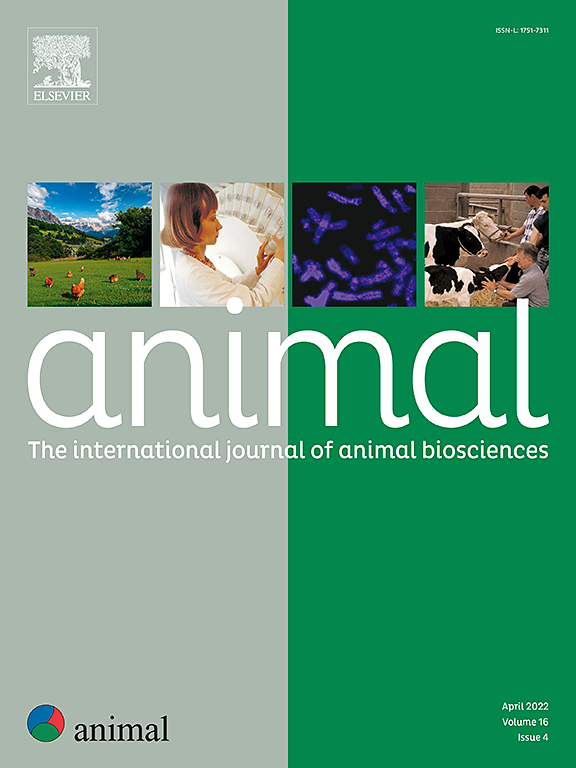Dietary supplementation with calcium peroxide improves methane mitigation potential of finishing beef cattle
IF 4
2区 农林科学
Q1 AGRICULTURE, DAIRY & ANIMAL SCIENCE
引用次数: 0
Abstract
Calcium peroxide (CaO2) offers potential as an anti-methanogenic dietary feed material. The compound has been previously assessed in vitro, with methane (CH4) reductions of > 50% observed. The objective of this study was to assess dietary supplementation of CaO2 at different inclusion levels and physical formats in a finishing beef system on the effects of animal performance, gaseous emissions, rumen fermentation parameters and digestibility. Seventy-two dairy-beef bulls (465 kg; 16 months of age) were randomly allocated to one of four treatments supplemented with CaO2; in a coarse ration (1) CON (0% CaO2), (2) LO (1.35% CaO2), (3) HI (2.25% CaO2), and in a pellet (4) HP (2.25% CaO2) (n = 18). Animals received their respective treatments for a 77 d finishing period, during which DM intake (American Calan Inc., Northwood, NH), average daily gain (ADG), feed efficiency and enteric emissions (GreenFeed emissions monitoring system; C-Lock Inc., Rapid City, SD) were measured. The finishing diet was isonitrogenous and isoenergetic across the four treatment groups, composed of 60:40 grass silage:concentrate. Silage was offered each morning (0900 h), and concentrates were offered twice daily (0800 and 1500 h). Supplementation of CaO2 had no effect on final weight (P = 0.09), ADG (P = 0.22) or feed efficiency (P = 0.13). Regarding DM intake, the HI treatment group consumed in the order of 1 kg less than CON (P < 0.01), while HP did not affect DM intake compared to CON (P = 0.79). Across treatments, DM intake ranged from 8.43 to 9.57 kg/d, equating to 1.6–1.8% of BW. Daily CH4 values for the control were 240 g/d, while CaO2 supplemented diets ranged from 202 to 170 g/d, resulting in daily CH4 reductions of 16, 29 and 27% for LO, HI and HP, respectively, compared to CON (P < 0.0001). Additionally, hydrogen was reduced in CaO2 supplemented animals by 32–36% relative to CON (P < 0.0001), with a simultaneous reduction in volatile fatty acid production (P < 0.01) and an increase in propionate concentration (P < 0.0001). Across all universally accepted CH4 metrics (yield, intensity, production), the dietary inclusion of CaO2 whether at a low or high rate, or indeed, through a coarse ration or pelleted format reduced CH4 in the order of 16–32%. This study also concluded that CaO2 can successfully endure the pelleting process, therefore, improving ease of delivery if implemented at farm level.
日粮中补充过氧化钙可提高育成肉牛的甲烷减排潜力
过氧化钙(CaO2)可作为一种抗甲烷生成的日粮饲料原料。以前曾对该化合物进行过体外评估,观察到甲烷(CH4)减少了 50%。本研究的目的是评估在育成牛肉系统中以不同的添加量和物理形式补充 CaO2 对动物性能、气体排放、瘤胃发酵参数和消化率的影响。72 头奶牛公牛(465 千克;16 月龄)被随机分配到四种补充 CaO2 的处理中的一种;粗饲料(1)CON(0% CaO2)、(2)LO(1.35% CaO2)、(3)HI(2.25% CaO2)和颗粒饲料(4)HP(2.25% CaO2)(n = 18)。动物在 77 天的育成期接受各自的处理,在此期间测量 DM 摄入量(American Calan 公司,Northwood,NH)、平均日增重(ADG)、饲料效率和肠道排放物(GreenFeed 排放物监测系统;C-Lock 公司,Rapid City,SD)。四个处理组的育成日粮均为等氮等能日粮,青贮饲料与精饲料的比例为 60:40。青贮饲料每天早上(9:00)供应,精料每天供应两次(8:00 和 15:00)。补充 CaO2 对最终体重(P = 0.09)、ADG(P = 0.22)或饲料效率(P = 0.13)没有影响。在DM摄入量方面,HI处理组比CON处理组少摄入1千克左右(P <0.01),而HP与CON相比不影响DM摄入量(P = 0.79)。在所有处理中,DM摄入量为8.43-9.57千克/天,相当于体重的1.6-1.8%。对照组的每日 CH4 值为 240 克/天,而添加 CaO2 的日粮为 202 至 170 克/天,与对照组相比,LO、HI 和 HP 的每日 CH4 值分别减少了 16%、29% 和 27%(P < 0.0001)。此外,与对照组相比,补充 CaO2 的动物体内的氢减少了 32-36%(P < 0.0001),同时挥发性脂肪酸产量减少(P < 0.01),丙酸盐浓度增加(P < 0.0001)。在所有公认的 CH4 指标(产量、强度、生产量)中,日粮中添加 CaO2,无论是低添加量还是高添加量,甚至是通过粗饲料或颗粒饲料形式,都能减少 16%-32% 的 CH4。这项研究还得出结论,二氧化钙可以成功承受制粒过程,因此,如果在农场一级实施,可以提高输送的便利性。
本文章由计算机程序翻译,如有差异,请以英文原文为准。
求助全文
约1分钟内获得全文
求助全文
来源期刊

Animal
农林科学-奶制品与动物科学
CiteScore
7.50
自引率
2.80%
发文量
246
审稿时长
3 months
期刊介绍:
Editorial board
animal attracts the best research in animal biology and animal systems from across the spectrum of the agricultural, biomedical, and environmental sciences. It is the central element in an exciting collaboration between the British Society of Animal Science (BSAS), Institut National de la Recherche Agronomique (INRA) and the European Federation of Animal Science (EAAP) and represents a merging of three scientific journals: Animal Science; Animal Research; Reproduction, Nutrition, Development. animal publishes original cutting-edge research, ''hot'' topics and horizon-scanning reviews on animal-related aspects of the life sciences at the molecular, cellular, organ, whole animal and production system levels. The main subject areas include: breeding and genetics; nutrition; physiology and functional biology of systems; behaviour, health and welfare; farming systems, environmental impact and climate change; product quality, human health and well-being. Animal models and papers dealing with the integration of research between these topics and their impact on the environment and people are particularly welcome.
 求助内容:
求助内容: 应助结果提醒方式:
应助结果提醒方式:


